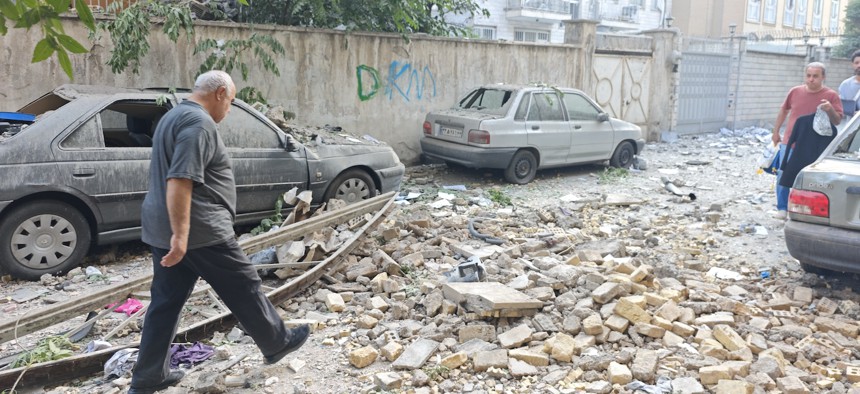
PRAGUE, Czech Republic — Hours after Israel began striking Iranian military leaders and nuclear sites, a former chief of Israeli military intelligence outlined four scenarios.
How they might unfold depends on the responses of the United States, China, Russia and Iran, Amos Yadlin said on Friday at the GLOBSEC security forum here. All of them, however, assume continued Israeli military action.
“It is not over yet. I think as we speak, airplanes are still flying into Iran to complete some of the job,” said Yadlin, who is currently an unofficial adviser to the Israeli government.
The former Israeli Air Force general praised the operation, describing it as a “unique” challenge given the secretive and dispersed nature of Iran’s nuclear weapons program, which includes “all kinds of enrichment sites, all kind of other nuclear sites all over the country.”
The strikes were “very good on nuclear, he said, but “nuclear is not enough,” and Israel must continue to strike other Iranian military assets, especially its 3,000 or so missiles.
Iran, meanwhile, has vowed to retaliate.
Four scenarios
Yadlin outlined four scenarios.
The first, he said, is a bilateral war between Israel and Iran, with the United States staying largely out. In describing the strikes on Friday morning, Secretary of State and acting national security advisor Marco Rubio carefully characterized them as a “unilateral” decision by Israel.
President Donald Trump had also publicly opposed an attack, yet Israeli leaders interpreted Trump’s stance as tacit approval—or at least non-interference, Yadlin said.
“I guess this was the case last night when Bibi called Trump, I think one hour before the attack,” he said.
Despite Trump’s public statements, he said, Israeli leaders believed Trump’s true message as: “You are threatened by a country that wants to destroy you. If you want to attack, attack. But we are not in the business… We are afraid that our soldiers in Qatar, in Bahrain will be attacked by Iran. So go for it. Good luck.”
As second scenario would see U.S. forces joining Israel to attack Iran, possibly triggered if Iranian retaliation affects the United States—say, by direct attack or by blocking oil traffic through the Strait of Hormuz.
One former U.S. Central Command official said the United States is unlikely to use its military assets to help Israel bomb Iranian sites, but that U.S. planners are preparing for contingencies.
“I know this is a specific concern: Say that an Israeli jet is shot down and an IDF pilot evacuates and lands somewhere in Saudi Arabia or something—is the U.S. military going to go and help rescue them? And then, in the fog of war, something happens?” the former official said.
Stimson Center CEO Brian Finlay agreed that the United States would likely try to limit its involvement but said the risks were rising.
“President Trump was very clear in the days leading up to these strikes that he did not want to see these strikes, that they are in a period of intense negotiations with Tehran. And so I think we are entering into what is clearly a much less stable place—not just with Iran, but I think, from Washington’s perspective, with America’s allies in the region as well,” Finlay said at GLOBSEC.
The third scenario would see the United States advance a U.N. Security Council resolution calling for an immediate ceasefire, making it diplomatically costly for Iran to retaliate.
“The Russians and the Chinese will be smart enough not to veto it,” Yadlin said, which would give Trump “much better cards” to negotiate with Iran.
In Yadlin’s final scenario, Russia and China—both allies of Iran—decide to back Tehran against Israel and possibly the United States, setting the conditions for a global conflict. He described that outcome as “unlikely.”
James Stokes, who directs of nuclear policy at NATO, told a GLOBSEC audience, said, “We are continuing to watch the situation overall in the Middle East, the ongoing conflicts that are happening there, and we’ll continue to.”
“Opportunity”
In justifying the attack, Israeli Prime Minister Benjamin Netanyahu said publicly that Iran was capable of building a nuclear weapon. U.S. officials have long warned that Iran could build a Bomb within weeks of deciding to do so.
A March report from the International Atomic Energy Agency noted: “Iran’s stockpile of uranium enriched up to 60% U-235 has increased to 275 kg, up from 182 kg in the past quarter. Iran is the only non-nuclear weapon State enriching to this level.”
“Uranium enriched at 60% purity is just a short, technical step away from weapons-grade levels of 90%,” AP wrote last year.
One official at an international organization that monitors nuclear testing said the group had not detected any indication that Iran had tested such a weapon.
Yadlin, a frequent critic of Netanyahu, said on Friday that Hamas’s October 2023, attack on Israel represented not only a brutal act of terrorism but also “a huge failure—intelligence failure, operational failure, leadership failure, political failure” by Israel’s leaders.
He was, however, supportive of the strikes on Iranian targets. He said the main impetus for the timing of Israel’s attack was the “opportunity” presented by the weakened state of Hamas, Hezbollah and the Assad regime in Syria—all close allies of Iran. “There was an opportunity, and it was maybe the last time.”
The post Former IDF intel chief lays out four scenarios for the Middle East appeared first on Defense One.




